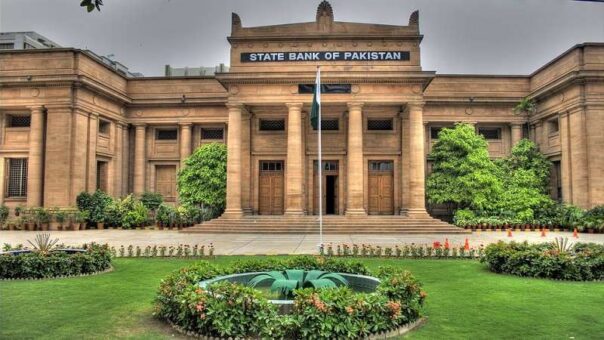Karachi, October 30, 2023 – Pakistan has chosen to uphold the benchmark interest rate at 22 percent, anticipating a substantial decline in inflation. In a statement released by the State Bank of Pakistan (SBP) on Monday, the Monetary Policy Committee (MPC) cited their outlook for a decreasing inflation trend.
The committee acknowledged that headline inflation had risen in September 2023, as anticipated. However, it is expected to recede in October and maintain a downward trajectory, especially in the latter part of the fiscal year. While global oil price volatility and an increase in gas tariffs from November 2023 present some risks to the inflation and current account outlook for fiscal year 2024, several offsetting factors were noted.
These factors include targeted fiscal consolidation in the first quarter, improvements in the market availability of key commodities, and the alignment of interbank and open market exchange rates.
The MPC highlighted key developments since their September meeting:
Encouraging initial estimates for Kharif crops are expected to positively impact various sectors of the economy.
The current account deficit significantly narrowed in August and September, stabilizing the SBP’s foreign exchange reserves position.
Fiscal consolidation remained on track, with improved fiscal and primary balances in the first quarter of fiscal year 2023-24.
Core inflation, although sticky, has been accompanied by improvements in inflation expectations from both consumers and businesses, according to recent pulse surveys. However, the uncertain outlook of global oil prices remains a concern.
Considering these developments, the MPC emphasized the importance of continuing a tight monetary policy stance. The MPC reiterated its view that the real policy rate remains significantly positive on a 12-month forward-looking basis, and it is deemed appropriate to achieve the medium-term inflation target of 5 – 7 percent by the end of fiscal year 2024-25. However, this outlook hinges on sustained fiscal consolidation and the timely realization of planned external inflows.
Recent data on economic activity has aligned with the MPC’s expectations of moderate growth this year. Notably, the latest production estimates for major Kharif crops indicate substantial increases compared to the previous year. Additionally, a moderate recovery is visible in other key activity indicators like cement, petroleum, oil, and lubricants (POL), and auto sales. Large-scale manufacturing (LSM) output has gradually improved in the first two months of the year, primarily driven by domestic-oriented sectors.
The MPC noted a substantial improvement in the current account balance, with the deficit decreasing over 58 percent year-on-year to $947 million in July-September fiscal year 2023-24. The balance almost leveled out in September 2023. Both exports and workers’ remittances exhibited improvements in September. Furthermore, reforms related to exchange companies and administrative actions against illicit market activities contributed to better foreign exchange market sentiments and liquidity. The improved inflows in the interbank market helped stabilize the SBP’s foreign exchange reserves around $7.5 billion as of October 20. However, the MPC stressed that a successful and timely completion of the upcoming IMF-SBA review would help unlock other multilateral and bilateral financing.
In the first quarter of fiscal year 2023-24, fiscal indicators improved compared to the same period in the previous fiscal year. The fiscal deficit improved to 0.9 percent of GDP from 1.0 percent, and the primary balance posted a surplus of 0.4 percent compared to 0.2 percent last year. This improvement is attributed to better revenue collection and restrained spending. The Federal Board of Revenue’s revenue recorded 24.9 percent growth year-on-year for the same period. Additionally, non-tax revenues almost doubled, mainly due to a sharp rate-driven increase in Public Debt Law (PDL) collection. Total expenditures remained at the previous year’s level, supported by a significant reduction in subsidies and grants. The MPC emphasized the importance of maintaining fiscal prudence and achieving targeted fiscal consolidation to keep inflation on a downward trajectory.
The broad money (M2) growth decelerated to 12.9 percent by the end of September, primarily due to the continued slowdown in private sector credit and seasonal reductions in commodity operations financing. The growth of reserve money also slowed down, explained by the significant deceleration in the growth of currency in circulation. Since June, the Net Foreign Assets (NFA) of the State Bank of Pakistan (SBP) and the banking system expanded, mainly due to substantial foreign exchange inflows in July. This led to an improvement in the composition of both M2 and reserve money. It is expected that planned fiscal consolidation and the realization of anticipated external inflows will create space for credit to the private sector and improve the NFA of the banking system.
As projected, headline inflation surged to 31.4 percent year-on-year in September. The MPC anticipates that inflation will significantly decline in October due to lower fuel prices, easing prices of certain major food commodities, and a favorable base effect. The Committee reiterated its assessment that inflation will decrease substantially in the second half of fiscal year 2023-24, barring any major adverse developments. However, the recent rise in global oil prices and the volatile trend, along with the second-round effects of a substantial increase in gas tariffs, pose some upside risks to the inflation outlook. Despite core inflation remaining elevated at around 21 percent for the last four months, fiscal policy measures, improved food commodity availability, and other stabilization efforts are expected to complement the central bank’s endeavors to reduce inflation.
State Bank of Pakistan to Unveil Monetary Policy Decision on October 30, 2023
